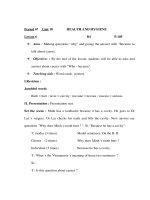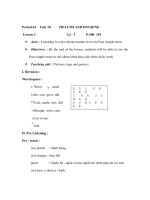Giáo án anh văn lớp 12 - Time allotted: 45 minutes - UNIT 5: HIGHER EDUCATION Section docx
Bạn đang xem bản rút gọn của tài liệu. Xem và tải ngay bản đầy đủ của tài liệu tại đây (50.96 KB, 6 trang )
Time allotted: 45 minutes
LESSON PLAN 12 (standard program)
UNIT 5: HIGHER EDUCATION
Section E: Language Focus
AIM: By the end of the lesson, students will be able to pronounce some words of
more than three-syllables and continue using conditional sentences in some
situations.
LEXICAL ITEMS: Words and phrases about Unit 5
TEACHING AIDS: Posters, textbook.
PROCEDURES:
Time Content
Teacher’s
activities
Students’
activities
2’
6’
@ Warm up:
- How many words are there in the
box?
* Pronunciation
- Sticks the
colorful poster
on the board and
asks the
question.
-Answer orally
-Go to the
board to put
10’
economics
psychology
philosophy
engineering
sociology
mathematics
geographical
archeology
* Practise reading sentences.
(page 59, textbook)
I. Presentation:
Conditional Sentences
Type 1:
Example:
How do you feel if you get good
marks?
- If I get good marks, I will feel
very happy.
- Divides the
class into 2
groups and asks
them to put the
stress on the
words.
-Plays the tape to
check the
answers.
-Continues
playing the tape.
-Asks the
question.
-Leading to the
the stress on
the words.
-Pronounce
-Listen &
repeat
- Listen &
repeat
-Listen &
answer
Form: If clause:
If clause Main clause
S + V
will
S + can + V
Meaning: This type of sentence
implies that the action in the if-
clause is quite probable.
Type 2:
a. Form:
If clause Main clause
S + V
2
ED
S + would
+ V
could
b. Usage:
-Type 2 refers to the present and
past tense in the if-clause is not a
true past but a subjunctive, which
indicates unreality or improbability.
c. Example:
example and
write it on the
board.
-Explains the
form and
meaning.
- Explains
- Shows the form
and usage.
-Take note.
- Listen
- Copy down
20’
She doesn’t buy a car. She doesn’t
have much money.
- If she had much money, she would
buy a car.
Type 3:
a. Form:
If clause Main clause
S + had +
V
3
ED
would
S+ should +have +
V
3
ED
could
b. Usage:
- It states that the action in the if-
clause was unreal and didn’t
happen in the past time.
c. Example:
If I had had time, I would have
seen the film.
II. Practice:
Exercise1: group work (page
- Explains
- Shows the form
and usage.
- Divides class
- Listen
- Copy down
- Work in
groups
- Write the
answers on the
5’
2’
119)
- Group 1: sentence 1 2
- Group 2: sentence 3 4
Write the answer on the board.
Exercise 2: Pair work
Checking: one students read
the first sentence, one student read
“if” sentence. Other students listen
and check.
Exercise 3: Individual work.
III. Production: Game
into 2 groups
- Asks each
group to write
the answers on
the board.
- Asks students
to work in pairs
- Asks each pairs
to read.
- Asks students
to do this
exercise
individually.
- Calls students
to write
sentences on the
board
- Corrects
board
- Work in pairs
- Read the
sentence
- Other
students listen.
- Do the
exercise
- Write the
answers
-Listen and
correct
(Reviewing 3 types of If clause)
- Group 1: If clause
- Group 2: main clauses and vice
verse
(a number of sentences depend on
the time)
@ Homework:
Students practise pronunciation
more at home, and make 2
sentences for each type of if-clause.
- Guides
students to play
game.
- Matches two
clauses and reads
-Asks Ss to do
homework.
- Listen and
play
-Individually









